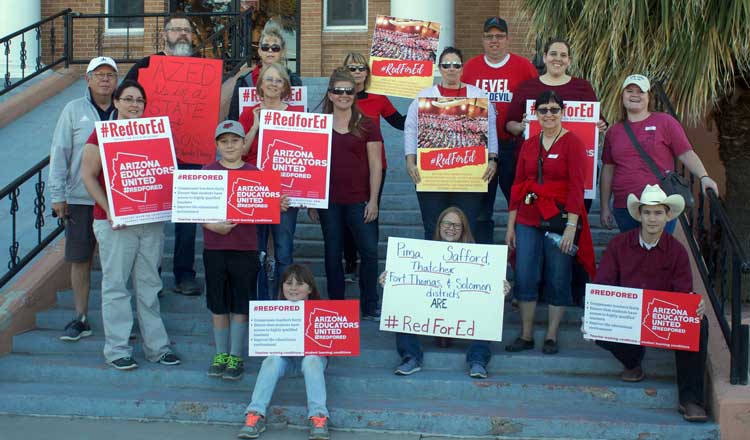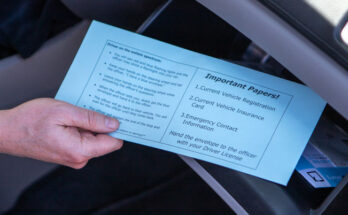Jon Johnson Photo/Gila Herald: Lakota Crockett, 10, left, and Alex Crockett, 11, display their signs for the #RedForEd march in Safford.
By Jon Johnson
SAFFORD – While their numbers may have been few, their voices were heard as a group of teachers, paraprofessionals and others led a local march Wednesday afternoon in the #RedForEd movement.
Roughly 2,500 educators and supporters marched to the capitol in Phoenix for a rally in which organizers called on the Arizona Legislature to support a 20 percent pay raise for teachers or face a possible strike. Recently, West Virginia teachers went on strike for nine days and prevailed with a 5-percent raise. A similar movement in Oklahoma may take place next week.
While local teachers decide to not take a half-day off work and instead show their solidarity by holding a local march after school, they might be taking a lot more days off if their demands aren’t met.
Decked out in red and carrying signs that reported their cause, the local march led participants on a 1.5-mile trek along U.S. Highway 70 as honks from highway traffic voiced support. The march started at the Tractor Supply Company in Thatcher and ended at the Graham County Courthouse at 800 W. Main St.

“Hopefully, what we did today will start making a difference and get people thinking,” Pima High School English teacher Natalie Schlittenhardt said.
Pima Elementary teacher Michelle Thompson organized the event with assistance from Pima’s Choir and Music instructor Michael Bradley. Thompson stressed that they were not protesting their local schools’ administrators, whom she said has their best interest in mind, but rather the lawmakers at the capitol and Governor Doug Ducey.
“Teachers work really hard and we are not fairly compensated for what we do,” Thompson said.
A study by the Morrison Institute found that, when including the cost of living in each state, Arizona ranks last in elementary teacher pay and 49th in high school teacher pay.
Bradley said that disparity has forced a number of teachers to switch professions to make a livable wage and has discouraged others from becoming teachers. That fact hit home for him as he told the Gila Herald that his own daughter’s dream job is to be a music teacher but she is studying for other venues because she refuses to try to live on a music teacher’s salary.
“There’s a lot of times where we’re losing the best and brightest who could be in the profession who have the desire to, they want to (become teachers); that’s where their heart is,” Bradley said. “But they see the reality of what the money looks like and they just won’t do it.”

“None of us got into it for the money,” Thompson said. “We’re here for the kids, but we feel we should make a livable wage.”
Bradley said he found it hard to believe Governor Ducey when he says he is doing all he can for teachers when they see tax cuts that benefit corporations and wealthy donors pass while spending for schools remains stagnate. He said to watch out for the power of the teachers.
“We were a sleeping giant,” he said. “You woke us up, so deal with it.”
“This is a statewide movement,” Thompson said. “If anything is going to happen, it’s going to happen now.”
In addition to the 20 percent increase, marchers at the Capitol rally also demanded:
- Restoration of per-pupil funding to 2008 levels. According to the Joint Legislative Budget Committee, Arizona spends $924 less per student than it did in 2008 after adjustment for inflation.
- No new tax cuts until said per-pupil funding reaches the national average. A National Education Association report showed Arizona spent $8,080 per pupil in 2016 compared to the national average of $12,682.
- A permanent pay structure where teachers would have guaranteed annual raises.
- Competitive pay for all employees in education.







